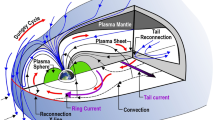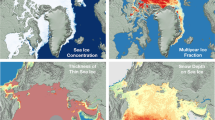Abstract
Strong disturbances associated with auroral substorms originate from the ionosphere–magnetosphere owing to the effects of the solar wind, and the wind field in the ionosphere is related to such substorm activity. Here, we describe the analysis of four auroral substorm events, for which we employed an all-sky Fabry–Perot interferometer to observe the two-dimensional horizontal wind field and combined the results with data from an all-sky charge-coupled device imager, a fluxgate magnetometer installed at Yellow River Station, and the Super Dual Auroral Radar Network. The results demonstrate that, during auroral substorms, the vector wind field is related closely to variations in the ion drift and geomagnetic field. Moreover, we observed a changing wind field of approximately 300 m/s in response to variations in the electric and magnetic fields (likely caused by ion drag) and a disturbance of about 200 m/s that we attribute to the interaction of Joule heating and ion drag.








Similar content being viewed by others
References
Kudeki E, Akgiray A, Milla M et al (2007) Equatorial spread-F initiation: post-sunset vortex, thermospheric winds, gravity waves. J Atmos Sol Terr Phys 69:2416–2427
Emmert JT, Fejer BG, Fesen CG et al (2001) Climatology of middle- and low-latitude daytime F region disturbance neutral winds measured by Wind Imaging Interferometer (WINDII). J Geophys Res 106:24701–24712
Rishbeth H, Müller-Wodarg ICF (1999) Vertical circulation and thermospheric composition: a modeling study. Ann Geophys 17:794–805
Rishbeth H (2004) Questions of the equatorial F2-layer and thermosphere. J Atmos Sol Terr Phys 66:1669–1674
Meurant M, Gérard JC, Blockx C et al (2004) Propagation of electron and proton shock-induced aurora and the role of the interplanetary magnetic field and solar wind. J Geophys Res 109:A10210
Du M, Sun W, Tsurutani BT et al (2011) Observations of dawn–dusk aligned polar cap aurora during the substorms of January 21, 2005. Planet Space Sci 59:1551–1558
Griffin E, Kosch MJ, Aruliah A et al (2006) Combined ground-based optical support for the aurora (DELTA) sounding rocket campaign. Earth Planets Space 58:1113–1121
Kosch MJ, Ishii M, Nozawa S et al (2000) A comparison of thermospheric winds and temperatures from Fabry–Perot interferometers and EISCAT radar measurements with models. Adv Space Res 26:979–984
Yuan W, Liu X, Xu J et al (2013) FPJ observations of nighttime mesospheric and thermospheric winds in China and their comparisons with HWM07. Ann Geophys 31:1365–1378
Hu GY, Ai Y, Zhang YG et al (2014) First scanning Fabry–Perot interferometer developed in China. Chin Sci Bull 59:563–570
Yuan W, Xu JY, Ma RP et al (2010) First observation of mesospheric and thermospheric winds by a Fabry–Perot interferometer in China. Chin Sci Bull 55:4046–4051
Anderson C, Conde M, Dyson P et al (2009) Thermospheric winds and temperatures above Mawson, Antarctica, observed with an all-sky imaging, Fabry–Perot spectrometer. Ann Geophys 27:2225–2235
Shiokawa K, Otsuka Y, Oyama S et al (2012) Development of low-cost sky-scanning Fabry–Perot interferometers for airglow and auroral studies. Earth Planets Space 64:1033–1046
Hysell D, Miceli R, Munk J et al (2012) Comparing VHF coherent scatter from the radar aurora with incoherent scatter and all-sky auroral imagery. J Geophys Res 117:A10313
Oyama S, Shiokawa K, Kurihara J et al (2010) Lower-thermospheric wind fluctuations measured with an FPI during pulsating aurora at Tromsø, Norway. Ann Geophys 28:1847–1857
Anderson C, Davies T, Conde M et al (2011) Spatial sampling of the thermospheric vertical wind field at auroral latitudes. J Geophys Res 116:A06320
Sutton EK, Forbes JM, Knipp DJ (2009) Rapid response of the thermosphere to variations in Joule heating. J Geophys Res 114:A04319
Kosch MJ, Yiu I, Anderson C et al (2011) Mesoscale observations of Joule heating near an auroral arc and ion-neutral collision frequency in the polar cap E region. J Geophys Res 116:A05321
Meriwether JW, Makela JJ, Fisher DJ et al (2013) Comparisons of thermospheric wind and temperature measurements in equatorial Brazil to Whole Atmosphere Model Predictions. J Atmos Sol Terr Phys 103:103–112
Zhang H, Ai Y, Zhang YG et al (2013) First observation of thermospheric neutral wind at Chinese Yellow River Station in Ny-Ålesund, Svalbard. Chin Sci Bull 58:1310–1315
Shiokawa K, Kadota T, Otsuka Y et al (2003) A two-channel Fabry–Perot interferometer with thermoelectric-cooled CCD detectors for neutral wind measurement in the upper atmosphere. Earth Planets Space 55:271–275
Li W, Xie Y, Deng SM et al (2010) Application of the Multigrid method to the two-dimensional Doppler radar radial velocity data assimilation. J Atmos Sol Terr Phys 27:319–332
Ogawa T, Nishitani N, Sato N et al (2002) Upper mesosphere summer echoes detected with the Antarctic Syowa HF radar. Geophys Res Lett 29:1157
Chisham G, Lester M, Milan SE et al (2007) A decade of the Super Dual Auroral Radar Network (SuperDARN): scientific achievements, new techniques and future directions. Surv Geophys 28:33−109
Hong MH, Wang XM, Chua D et al (2001) Auroral substorm response to solar wind pressure shock. Chin Sci Bull 46:1547–1551
Xu WY (2003) Geomagnetism. Seismological Press, Beijing (in Chinese)
Killeen TL, Roble RG (1984) An analysis of the high-latitude thermospheric wind pattern calculated by a thermospheric general circulation model: 1. Momentum forcing. J Geophys Res 89:7509–7522
Heelis RA, McEwen D, Guo W (2002) Ion and neutral motions observed in the winter polar upper atmosphere. J Geophys Res 107:SIA 17
Huang YS, Richmond AD, Deng Y et al (2012) Height distribution of Joule heating and its influence on the thermosphere. J Geophys Res 117:A08334
Richard AD, Lu G (2000) Upper-atmospheric effects of magnetic storms: a brief tutorial. J Atmos Sol Terr Phys 62:1115–1127
Acknowledgements
The correlation data referred in this study were obtained from an all-sky CCD imager and a fluxgate magnetometer at Yellow River Station by the Polar Research Institute of China (PRIC). The study also used ion drift data from SuperDARN and global geomagnetic data from the world data center (WDC). We extend our thanks to all of these institutions.
Author information
Authors and Affiliations
Corresponding author
About this article
Cite this article
Liu, J., Ai, Y., Zhang, Y. et al. Observations of thermospheric vector wind over Yellow River Station during auroral substorm events. Chin. Sci. Bull. 59, 3884–3893 (2014). https://doi.org/10.1007/s11434-014-0527-8
Received:
Accepted:
Published:
Issue Date:
DOI: https://doi.org/10.1007/s11434-014-0527-8




